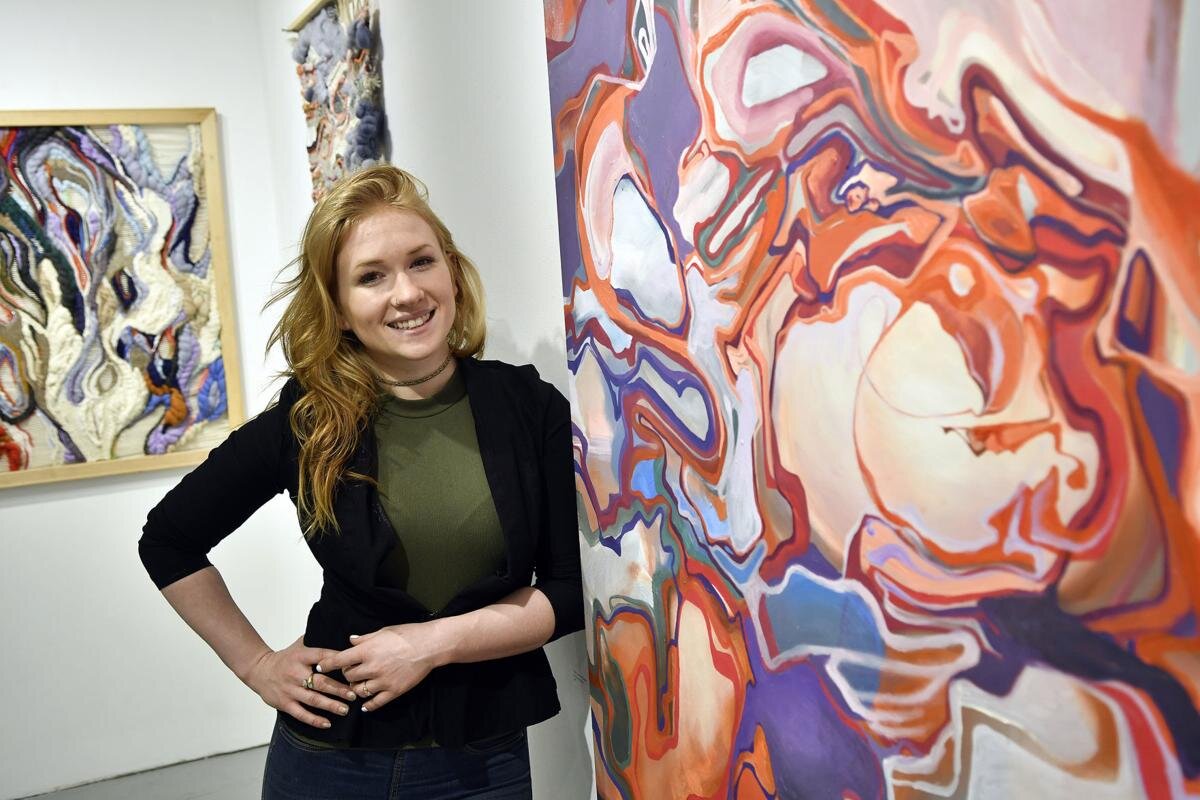Photo by Wolf Matthewson
So Rhode Island Magazine
By Robert Isenberg
When Sarah Swift begins a new project, she starts with a loom. But the materials she weaves into that loom could be anything: wool, silk, rubber, and twisted plastic bags. The compositions come together as tapestries of found fibers, dreamlike collisions of color.
“It’s always organic,” she says. “The materials evolve in these cycles. I’ll photograph a piece of work, blow it up, and then use that for a new piece. I’m fascinated with the buildup and breakdown of natural phenomena.”
During the day, Swift is the director of Hera Gallery in Wakefield, where she schedules programming and helps curate shows. Then she retires to her apartment, where her living room doubles as a studio. After years of developing her abstract style, Swift is reaching a broad new audience: she’s scheduled to show her work in four different shows by the end of 2018. Her solo show, “FLUX: Cycles of Change,” just closed at Hera Gallery.
“I figured I would be exhausted,” she says. “But I’ve been so motivated to do more work.”
Swift grew up in Exeter, the child of marine biologists, and she yearned for urban culture. She went to the Pratt Institute in New York City to study painting, and she stayed in the city for seven years. She presented her work at some group shows, but the competition was cutthroat.
“I wasn’t getting the shows I wanted,” she recalls. “I did okay, but it wasn’t the community that I wanted.”
To clear her head, Swift backpacked alone in Europe for three months. After touring museums in 13 countries, she felt rejuvenated and returned to Rhode Island. But before she could make her next move, she learned that Hera Gallery was looking for a new director. Swift started volunteering, made her interest known, and was eventually hired. The directorship is full of responsibility, a tall task for any 25-year-old. But Swift loves her new role, and working with artists all day has only heightened her enthusiasm for her own projects, particularly the weaving…
Artwork from 8 Visions: Brian McClear, Avocado and Rivets, oil.
Artscope Magazine
by Brian Goslow
The selection process for “8 Visions,” opening at the Attleboro Arts Museum on August 1, began during last December’s members’ exhibition at the museum, when juror Sarah Swift, Gallery Director at Hera Gallery in Wakefield, Rhode Island, reviewed portfolios from over 60 submitting artists.
“I am a sucker for texture and materiality, particularly in application,” said Swift, explaining her selection process. “I looked for artists whose use of material seemed not just thoughtful, but ‘necessary’ to the contextual completion of their piece. I also looked for artwork that carried a visceral weight to it. I have personally been most interested in work that touches on our humanistic relationships to both the man-made and the natural world. Many of these artists chosen are creating works that convey a sensory experience of color and light, material touch, and spatial relationships with everyday items.”
Swift selected 20 artists from the original group, whose works were then reviewed by Artscope publisher Kaveh Mojtabai and Galatea Fine Art director Hilary Tait Norod…
The Independent
ARTIST PROFILE
What is your preferred medium? Why? My recent textile work has fascinated me, so I continue to return back to it. There is a tactile quality to working directly with my hands that I have responded to, that I haven’t found in painting or printmaking. I love the intimacy and touch to the materials, as I interlace fibers with one another.
How would you describe your work? I think of my studio practice as a giant science experiment. Using what I know, and then playing with things I don’t understand. My work and process systematically mimic the ongoing cycle of buildup and breakdown found in natural phenomena. On the most basic level, I’m investigating the cycles of life and death. On a more complex level, I think of changes of season, habits and patterns of daily living, relationships, even the patterns in the economy and stock market. I love this idea that everything is in a constant state of flux, ebbing and flowing and reacting to everything around it.
What was the inspiration for a recent body of work? The idea of creating a sustainably-conscious studio practice entered my mind in art school when supplies were expensive, and I had reusable material everywhere. I started favoring the processes of finding string, fabric, wood, or plastic and giving it all a new purpose. As political powers have shifted in the last year, the subjects of climate change and the global plastic epidemic came to my mind. I decided to put more effort into using material that I intended to dispose of: garbage. I begin hording plastic bags to be woven into tapestries and into my floor loom. I shred old, ripped clothing, and unravel old sweaters. All material I receive goes through a process. Whether it is painted, cut, collaged, or shredded, it is always somehow pieced back together; everything in a constant cycle of change…



